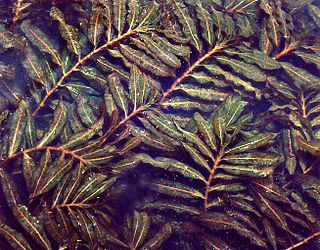
The Portulacaceae are a family of flowering plants, comprising 115 species in a single genus Portulaca. Formerly some 20 genera with about 500 species, were placed there, but it is now restricted to encompass only one genus, the other genera being placed elsewhere. The family has been recognised by most taxonomists, and is also known as the purslane family. It has a cosmopolitan distribution, with the highest diversity in semiarid regions of the Southern Hemisphere in Africa, Australia, and South America, but with a few species also extending north into Arctic regions. The family is very similar to the Caryophyllaceae, differing in the calyx, which has only two sepals.

The Potamogetonaceae, commonly referred to as the pondweed family, is an aquatic family of monocotyledonous flowering plants. The roughly 110 known species are divided over six genera. The largest genus in the family by far is Potamogeton, which contains about 100 species.

Cynoglossum is a genus of small-flowered plants in the family Boraginaceae.

The Simaroubaceae are a small, mostly tropical, family in the order Sapindales. In recent decades, it has been subject to much taxonomic debate, with several small families being split off. A molecular phylogeny of the family was published in 2007, greatly clarifying relationships within the family. Together with chemical characteristics such as the occurrence of petroselinic acid in Picrasma, in contrast to other members of the family such as Ailanthus, this indicates the existence of a subgroup in the family with Picrasma, Holacantha, and Castela.

Cenchrus is a widespread genus of plants in the grass family. Its species are native to many countries in Asia, Africa, Australia, the Americas, and various oceanic islands.

Desmodium is a genus of plants in the legume family Fabaceae, sometimes called tick-trefoil, tick clover, hitch hikers or beggar lice. There are dozens of species and the delimitation of the genus has shifted much over time. Species are distributed widely – from Quebec to northern Argentina in the Americas, across northern and southern tropical Africa, in the southern Arabian Peninsula, in Myanmar and Thailand, New Guinea, and northern and eastern Australia.

The genus of the myrrhs, Commiphora, is the most species-rich genus of flowering plants in the frankincense and myrrh family, Burseraceae. The genus contains approximately 190 species of shrubs and trees, which are distributed throughout the (sub-) tropical regions of Africa, the western Indian Ocean islands, the Arabian Peninsula, India, and South America. The genus is drought-tolerant and common throughout the xerophytic scrub, seasonally dry tropical forests, and woodlands of these regions.

Andropogon is a widespread genus of plants in the grass family, native to much of Asia, Africa, and the Americas, as well as Southern Europe and various oceanic islands.

Setaria is a widespread genus of plants in the grass family. The name is derived from the Latin word seta, meaning "bristle" or "hair", which refers to the bristly spikelets.

Zygophyllum is the type genus of the flowering plant family Zygophyllaceae. The generic name is derived from the Greek words ζυγόν (zygon), meaning "double", and φυλλον (phyllon), meaning "leaf". It refers to the leaves, each of which have two leaflets.
Pseudozoysia is a monotypic genus of plant in the grass family. The only known species is Pseudozoysia sessilis, found only in Somalia.
Acrachne is a genus of Asian, African, and Australian plants in the grass family. Species in the genus are commonly known as goosegrass.
Afrotrichloris is a genus of East African plants in the grass family.

Arctophila is a genus of Arctic and Subarctic plants in the grass family. The only known species is Arctophila fulva, commonly known as pendant grass, native to northern parts of Eurasia and North America.

Apluda is a genus of plants in the grass family native to Asia and to various islands in the Indian and Pacific Oceans.
Austrofestuca, called beach fescue, is a genus of Australian and New Zealand plants in the grass family. The only accepted species is Austrofestuca littoralis, native to seacoast regions in Australia and New Zealand.
Tetrachaete is a genus of plants in the grass family. The origin of the genus name is Greek, from tetra for "four" and chaite, for "bristle." There is only one known species, Tetrachaete elionuroides, native to Eritrea, Ethiopia, Somalia, Kenya, Tanzania, Yemen, and Oman.

Urochloa is a genus of plants in the grass family, native to Eurasia, Africa, Australia, Mexico, and the Pacific Islands. Common names include signalgrass.
Trichopteryx is a genus of African plants in the grass family.
Microcharis is a genus of flowering plants. It includes 36 species of herbs and shrublets native to Africa and the Arabian Peninsula. The genus is in tribe Indigofereae of family Fabaceae. Typical habitats include seasonally-dry tropical forest margins, woodland, thicket, wooded grassland, and grassland, often in damp, swampy, or riverine areas, or in shallow soil over rocks.













